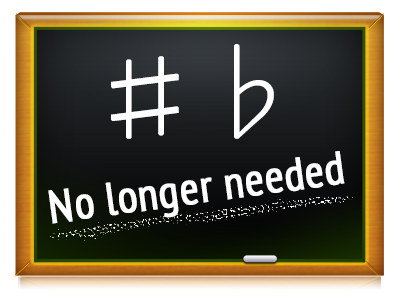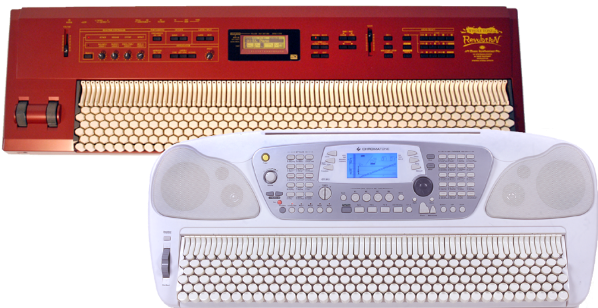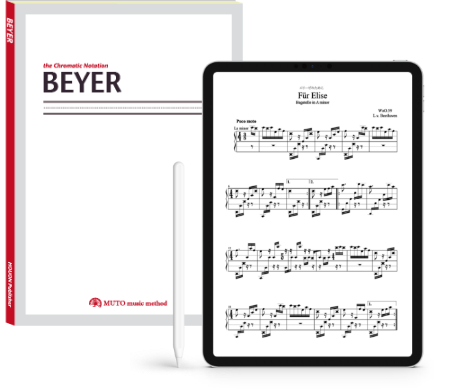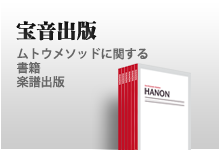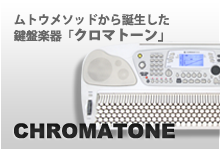Highly rational ! human friendly music method that lets you learn music naturally.
You do not have to be able to read ‘5 line notation.’
The biggest characteristic of Muto Music method --- it enables anyone to understand music easily, obtain musical sense very rapidly and improve so quickly.
Now we are going to explain why Muto Music Method is such rational in this site. We show the comparisons with 5 line notation and piano so that readers can understand easily in theory. But upon start of Muto Music Method, you do not have to understand 5 line notation and piano necessarily. You will see the whole reason and mechanism of music, and you will get to know why we say ‘you do not have to be able to read 5 line notation’.
Welcome to Muto Music Method !
The Concept of Muto Music Method.
Eliminate the difference of White and Black Keys, and treat 12 notes equally.
By doing that, the distance between notes gets clear and it becomes easier to grasp music intuitively.
As a foundation of the Muto Music Method, we have the concept that ’12 notes in 1 octave are independent’. For example, if we write ‘Do#’, it creates the impression like ‘A note attendant to Do’ and it looks as there is no place for black keys. However, in 12 temperament method, 12 notes are equally divided, and each one is independent note.
In order to materialize the Chromatic System, we designed and invented totally new notation method, << Chromatic Notation (3 lines music notation method) >> and << Muto Chromatic Keyboard >>.
There is no clef such as # and♭. There is no black key nor white key on the Chromatic Keyboard as well. Instead of indicating 12 notes with clefs (#♭) or with black color, we treat each note equally as independent one, we can eliminate the difference between difficult keys and easy keys, better notes and worth notes. And we can make it clear the distance between the notes. These are the epoch making instrument and notation that solve the problems of Piano and 5 lines music notation, and make music easier and intuitive to play.
Muto Method is not a new theory. It is same as the traditional method in terms of the concept of 12 temperament method and composition method except for changing the viewpoint. We just lost excess weight accumulated in the hundreds of years, and organized the things in the most simple way and made it easy to understand. However, by just doing so, the vast amount of time required to master Piano is shortened to a fraction, and people can enjoy the music in the short period of time. In the same amount of time of learning, any people – old and young, men and women – can master Muto Music Method, as it is easier to read music notation and to understand music.
Instead of thinking or memorizing required in the current music education, you can play music as you see and as you feel … That is <<Muto Music Method>>.
New Music Theory ‘Muto Music Method’
‘I want to play instruments freely as I feel !’
Anyone must have thought like that once. And any person has potentiality to make it happen. But current music education repeatedly eliminated ‘musical sense’ instead of raising the future musicians. We wonder how much problems are being created by music education featuring Piano and 5 lines music notation... A few of music industry people notice the fact, but it is not yet mainstream that overturns the long history regrettably. The ordinary people never know the fact that the current music education is wrong.
The problem of 5 lines music notation
Sharp, Flat, Clef… Singing is fun, but haven’t you ever quitted learning Piano as the 5 line music notation is too difficult ? No wonder. Because the distance of the notes are not correctly indicated with lot of signs.
DO and MI, FA and LA, SO and SI are major third. RE and FA, MI and SO, LA and DO are minor third. The distance between the notes are different in the case of major third and the case of minor third However, it is indicated as same distance in the 5 line notation method (please see the below chart).
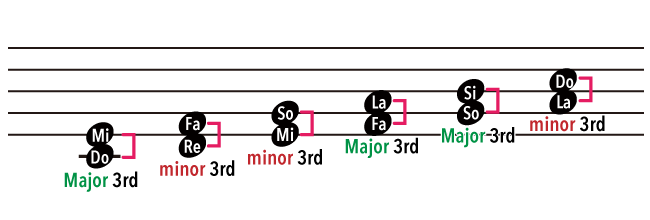
Humans capture the distance by the image. If indicated as same distance in the notation, we recognize it as same distance. So we get confused as the distance of the tones heard actually causes conflict with the distance recognized by eye. Some people get sick as they cannot overcome this problem.
Sharp, Flat, G clef, F clef, C clef… There are many signs that make things complicated in the 5 lines notation. This creates the thought that ‘you cannot master music if you do not start it in the childhood’ in order to memorize the signs like cipher to read music notation smoothly.
We can learn how to run or how to speak naturally. But we need to study 5 lines music notation. The children are forced unnecessary efforts in the music education with 5 lines music notation. Moreover, by being forced with 5 lines music notation, the relative pitch that each person owns naturally are hindered. The children cannot play music without music notation after being forced with 5 lines music notation when their brains were flexible. A lot of problems like ‘cannot sing’ , ‘cannot compose’, ‘lost musicality’ are created by learning piano, although they started learning piano to be able to enjoy playing music freely.
You do not need special ability to play music.
In Muto Music Method, we eliminated chromatic signs such as Sharp and Flat, and also clefs such as G clef and F clef, then we positioned 12 notes in one octave equally in the same distance. This is the new method of music notation called Chromatic Notation that we invented. Thanks to this, in Chromatic Notation, the distance between notes are kept same after changing keys, while 5 lines notation required us to memorize notes positioned all differently in the 12 types of keys. In other words, once you remember the positions of notes in 1 octave, you can read notes in any keys. And we gave notes unique names, as they were assigned on the black keys with no official name. Accordingly, we made it possible to read 1 octave smoothly as Do, di, Re, me, Mi, Fa, fi, So, lu, La, se, Si, Do.
It remains same in the music notation.
Real tone and the distance between notes on the notation are correctly matched. This makes it clear in terms of sense of pitch, scale and chord system. We can understand music deeply in natural manner. Chromatic Notation that Muto Music Method created enables people to grasp scale instantly and also to read music in the short period of time.
Here you can find Chromatic Notation System and how to read it.【PDF】
CHROMATONE, a keyboard based on Muto Method.

And Muto Chromatic Keyboard (RAPIAN, WHOLETONE, CHROMATONE) are produced based on the latest Muto Music Method.
Muto Chromatic Keyboard has halftone positioning keys and wholetone positioning keys in combined manner, and position keys in the equal interval. Diagonal lines are halftone, horizontal lines are wholetone, and vertical lines are synchronized. Therefore you can arrange positions or fingerings for your ease to play, according to the size of your hands or length of your fingers. You can play keys flexibly and effectively according to the phrase of the tunes. You can even play the phrase that you could not with traditional Piano keyboard.
You keep same way of playing in any keys. You just remember a few types of Chords and shift in parallel way matching to root note. You can learn how to play in the short period of time and you can understand chord mechanism and get relative pitch naturally.
Also Muto Chromatic Keyboard is not an instrument to choose with sound or function, as the criteria of choice about instrument is totally different from other keyboards. Muto Chromatic Keyboard is the controller (keyboard) that enables us to learn music rationally and correctly in the short time of period, and also broaden new possibility of music in the future such as new method of play or voicing. You can solve the problem of adding your favorite sounds and functions by adding existing external sound source via MIDI.
Muto Music Method lets you play music instinctively.
As generally known, in 1 octave that is ‘Do, Re, Mi, Fa, So, La, Si, (Do)’, in addition to these 7 notes, 5 notes exist. If we use an example of 5 lines notation, the 5 notes other than‘Do, Re, Mi, Fa, So, La, Si, (Do)’ are indicated specially with the signs like # and ♭. Also, in the case of Piano, white keys are ‘Do, Re, Mi, Fa, So, La, Si, (Do)’. On the other hand, black keys with the special atmosphere are 5 other notes mentioned earlier. These 5 notes do not have official names. For example, the note of black key between Do and Re is Do# or Re♭. As you see, it is indicated with signs and being called in 2 ways. How come this independent note does not have name although it is different from Do or Re ?

These 12 notes are located like stairway with each other, with same height (interval) of difference one to next. Muto Music Method (= Chromatic System) made no difference between Blacks and Whites, does not use signs like # and ♭, position 12 notes in 1 octave like stairway, and treat all the notes equally. We named the notes assigned on the black keys as DI, ME, FI, LU, SE. We call 1 octave as ‘DO, DI, RE, ME, MI, FA, SO, LU, LA, SE, SI, DO’.

In Muto Music Method (=Chromatic System) , the notes next to each other always keeps same ‘distance (interval)’.
Owing to this, the following epoch making merits were created.
- You can grasp interval instinctively.
- You can strengthen the relative pitch sense naturally.
- You can keep same form in any key.
The 3 sense – Sense of sight (Vision), Sense of play (Touch), Sense of listen (Aural) – are correctly matched. It does not exist level of difficulty according to the key, you can master music very rapidly in any music genre. Also, you can learn correct sense of pitch and music theory naturally. You can benefit great effects that you could not get with the traditional Piano and 5 line notation method. The negative image that is ‘white key is easy and black key is difficult’ is now gone !
You can accompany songs with 2 chord forms.
Muto Music Method treats 12 notes in 1 octave as independent notes equally instead of indicating them with black key and with # and ♭. For example, if we write DO#, it gives an impression of ‘the note attendant on DO’, and you may think of black key note as restless note. However, 12 notes are equally divided in the primary manner and these 12 notes are independent notes. In our method, as we eliminated the differentiation between black and white, lined up 12 notes like stairway, you can play in same way in any keys. And now there is no difficult key or easy key, there is no better note or worth note, and the distance between notes are clear.
In Muto Music Method, there is no difference between keys and people can understand music easily that means it is friendly method to any people – old or young, men or women. For example, you can play basic accompaniment just with major and minor – DO,MI,SO and DO, ME (MI♭), SO chord form. Because the basic of diatonic chord consists of combination of major 3rd and minor 3rd . 3 chords have the cases of major & minor, minor & major, minor & minor and major & major. But as the minor & minor and major & major are very special cases, if you learn other 2 forms, you will be able to accompany most of the songs.


